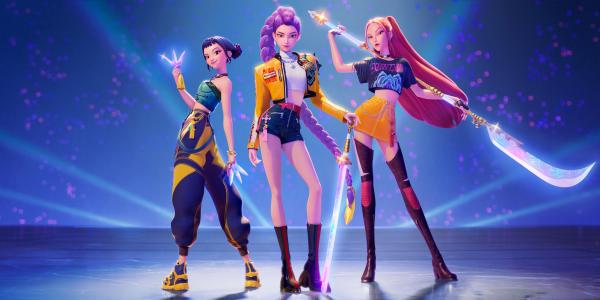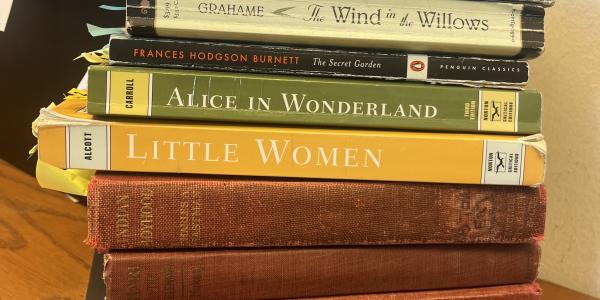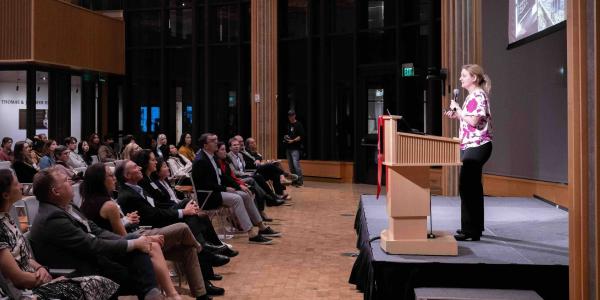Filmmakers of Netflix’s hit “KPop Demon Hunters” partnered with teaching professor Mijeong Mimi Kim to infuse authentic Korean culture into a vibrant fantasy world.

When Mijeong Mimi Kim first saw the email, she thought it might be a phishing scam.
A film executive had written to her, asking if she’d like to work as a cultural advisor on an upcoming animated film set in South Korea. The title: “KPop Demon Hunters.” Kim, a teaching professor of Korean language at WashU since 2002, had never worked on a film or television series before. Why was he writing to her?
After doing some internet research to confirm that this producer was legitimate, Kim decided to take the leap and meet with the film’s directors. That’s when she first heard the story pitch.
“It was about K-pop idols working as undercover demon hunters,” Kim said. “I had never heard anything like it. But I thought, ‘Why not? If characters like Spider-Man or Batman could become famous, why not K-pop idols fighting demons?’”
As wild as the premise seemed, Kim was impressed that co-directors Maggie Kang and Chris Appelhans were committed to grounding their fantasy tale in rich and authentic details from Korean culture. Media portrayals are a sensitive spot for Koreans, Kim said, who are used to seeing their culture conflated or confused with Japanese, Chinese, or southeast Asian traditions in Western films and television.
So, in 2021, Kim accepted the role. Fast forward to 2025, and “KPop Demon Hunters” has surged to success far beyond what Kim or the film’s creators had ever anticipated. The film is already Netflix’s most-watched original film of all time. Its soundtrack, featuring original songs by fictional K-pop groups HUNTR/X and Saja Boys, has charted numerous hits on the Billboard Hot 100, with breakout single “Golden” peaking at No. 1. Movie theaters are hosting sing-along screenings of the film, appealing to a hardcore fanbase who already knows every song lyric.
And Kim’s role in refining the film, though it could have gone unsung, is garnering attention. In a recent interview with Forbes, Kang and Appelhans praised her involvement.
“She helped us integrate cultural specificities authentically in both storytelling and character/environment/prop design,” the directors wrote in an email to Forbes. “She was an important part of the process from beginning to end.”
The Ampersand spoke with Kim about how the film’s creative process unfolded across multiple years, and what its smashing success means to her.
How did the process of reviewing the film work?
At the beginning, they would send a bunch of drawings and storyboards, and I would comment on those. But then, as time passed, they had me viewing segments of the film. It wasn’t a constant interaction, but every few months, they would send a bunch of pictures and drawings, and later, animation.
I learned a great deal about making animation through this! I never knew this before, but they have preliminary voice actors who read the lines, even if they aren’t the complete lines later seen in the movie. I would point out their pronunciation of certain words, like how the actors would say “ramen” instead of “ramyeon,” and there were some expressions or terminologies where I would ask, “Do you really want to use this?”
What standards did you apply in reviewing the film’s aesthetic choices, and what elements jumped out at you while you were watching?
On the one hand, it’s K-pop stars fighting demons at night, so how authentic can you be, right? The real K-pop stars don’t even wear authentic clothes anymore — it’s all Westernized and modified. But when they were portraying traditional scenes, it had to be accurate. That included the way people wear their hair, the way they eat, the buildings, and the monsters. I did a lot of research.
There were two things that Koreans mentioned right away when the movie was released. They were amazed we got the right type of sword that the main character uses, because there are similar swords in Japan and China. I remember digging through a lot of things to compare and make sure that this was a Korean-style weapon. The other was the knottings, or norigae, that the characters use as accessories.

How have Koreans received the film?
Koreans in Korea can be quite touchy when it comes to culture. It’s because of the history with Korea between Japan and China, those continuous interactions — and sometimes oppressions. In the past, Koreans have been portrayed as wearing Japanese clothes or living in Chinese-looking buildings.
I was a little bit nervous when the film released in June. When I heard the first reaction was that Koreans were grateful for how authentically their culture was represented, I thought, “Yay!” They were ecstatic. It was like, “They got it. You mean it’s not produced by people here?” They are really tickled that somebody else made a Korean-set movie so authentically.
This isn’t the first time — even at Netflix — that Korean culture has crossed over in a massive way with Western audiences. From TV shows like “Squid Game,” movies like “Parasite,” and K-pop stars like PSY, BTS, and BLACKPINK, Korean culture continues to find incredible success globally. In your view, what about that culture exports so well to the West?
Number one: I think a different generation had to happen first. Because I don’t think it would have played out the same in the ’80s, ’90s, or even the 2000s. This is a more interconnected world, with easy access to different cultures at the tip of our fingers — Netflix, YouTube, and all that.
That said, works such as “Parasite” and “Squid Game” reveal universal aspects of human nature — both its strengths and its flaws. Their power lies in their unflinching honesty, resisting any impulse to soften or idealize reality. They present everything with remarkable polish. Take BTS, for example — watching them perform makes clear the extraordinary dedication behind their craft. Many of them have been training intensively since early adolescence, around the ages of 12 to 14. When you see a K-pop group on stage, the effect is what I’d call “unrealistically good,” because it seems almost beyond human capacity to maintain that level of precision and energy. They sing and dance seamlessly, never missing a beat.
“When I heard the first reaction was that Koreans were grateful for how authentically their culture was represented, I thought ‘Yay!’”
—Mijeong Mimi Kim
How does your work on this movie connect with your work as a teaching professor?
I use all of my cultural lessons in language classes, because the language cannot be separated from culture. I think this project was an easy transition for me because I’ve always paid attention to how culture is portrayed. We have some extracurricular activities where I’m going to show the Korean-language version of “KPop Demon Hunters” and have the students make kimbap, a traditional Korean dish that appears in the film.
I’m not teaching my students to become Koreans, but, instead, to become effective communicators of a language. And intercultural communication occurs in many different forms. By watching these movies, they get to see a different culture and identify the common beliefs that are important to every human being.
Header image: A still from the Netflix animated movie “KPop Demon Hunters.” (Credit: Netflix)





